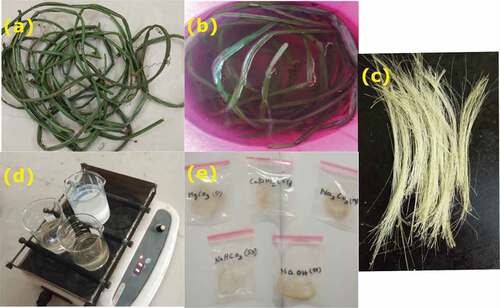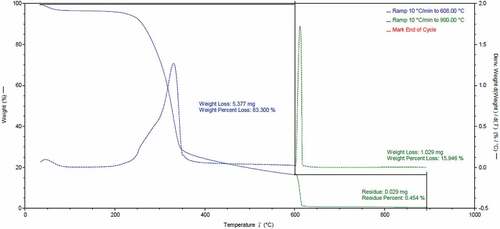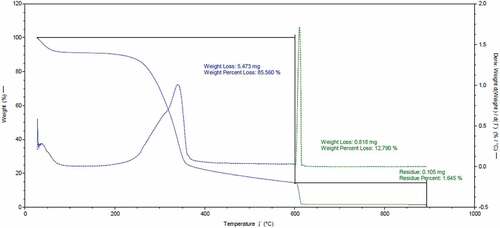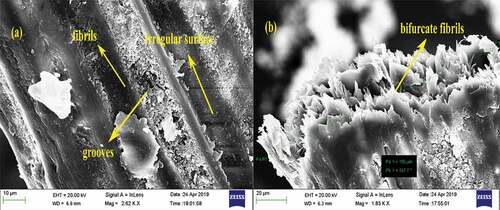 ?Mathematical formulae have been encoded as MathML and are displayed in this HTML version using MathJax in order to improve their display. Uncheck the box to turn MathJax off. This feature requires Javascript. Click on a formula to zoom.
?Mathematical formulae have been encoded as MathML and are displayed in this HTML version using MathJax in order to improve their display. Uncheck the box to turn MathJax off. This feature requires Javascript. Click on a formula to zoom.ABSTRACT
The increasing demand for natural fiber-reinforced composites has opened up the market for inexpensive, lightweight, bio-renewable, and environment-friendly plant fibers. The chemical treatments on fiber lead to the reduction of lignin and hemicellulose contents which helps in better adhesion with the matrix. The objective of this work is to do various chemical treatments on Cissus quadrangularis Stem Fiber (CQSF) and perform its characterization. The natural fibers are first extracted from the Cissus quadrangularis stem using the retting process. The fibers are then chemically treated with magnesium carbonate (MgCO3), sodium hydroxide (NaOH), sodium carbonate (Na2CO3), sodium bicarbonate (NaHCO3), and calcium hydroxide (Ca(OH)2). The characterization of single fibers is investigated by single-fiber tensile test, chemical composition, thermogravimetric analysis, and field emission scanning electron microscope. Characterization results show that the MgCO3-treated CQSF has improved mechanical and thermal properties. Thus, MgCO3-treated CQSF is suggested for biocomposite preparation due to its promising mechanical properties and thermal properties.
摘要
对天然纤维增强复合材料日益增长的需求为廉价、轻质、生物可再生和环境友好的植物纤维开辟了市场. 对纤维的化学处理导致木质素和半纤维素含量的减少,这有助于更好地与基质粘合. 本工作的目的是对四角刺五加茎纤维(CQSF)进行各种化学处理,并对其进行表征.
首先使用脱胶工艺从四角刺五加茎中提取天然纤维.然后用碳酸镁(MgCO3)、氢氧化钠(NaOH)、碳酸钠(Na2CO3)、碳酸氢钠(NaHCO3)和氢氧化钙(Ca(OH)2)对纤维进行化学处理. 通过单纤维拉伸试验、化学成分、热重分析(TGA)和场发射扫描电子显微镜(FESEM)研究了单纤维的表征。表征结果表明,MgCO3处理的CQSF具有改善的机械性能和热性能. 因此,MgCO3处理的CQSF由于其良好的机械性能和热性能而被建议用于生物复合材料的制备.
Introduction
Polymer composite preparation depends on the reinforcement and matrix. Synthetic fibers have some drawbacks, such as high fiber cost, high energy consumption for composite manufacturing, poor recyclability, non-renewability, non-biodegradability, health hazards, and carbon dioxide (CO2) emissions (Jagadeesh et al. Citation2021; Madhu et al. Citation2022). These shortcomings have resulted in the shifting of the focus of the scientific community to a better alternative of natural fibers (Kumar et al. Citation2021). The natural fibers offer many significant advantages like lesser cost, low density with high specific strength, biodegradability, non-abrasive nature, and renewability. Owing to the increased demand for natural fibers and the achieved superior composite properties, there is an ongoing search for new and better fibers by researchers (Puttegowda et al. Citation2020). Several new natural fibers were introduced and investigated by various researchers some of which are Kigelia africana (Siva et al. Citation2020), Cyperus pangorei (Mayandi et al. Citation2016), Napier Grass Fiber Strands (Kommula et al. Citation2013), Cissus quadrangularis (Siva et al. Citation2021b), and Areca (Yashas Gowda et al. Citation2022). For better composite properties, the adhesion between the fiber and the matrix is important. In general, the raw natural fiber has a smoother surface due to the presence of wax which leads to weak surface adhesion due to poor wetting in composite preparation. The surface modification on natural fiber results in the presence of a rough surface and improved aspect ratio which could help in better adhesion between fiber and resin. Physical treatments like calendaring, ozone treatments, plasma treatments, thermal treatments, and chemical treatments like alkaline, silane, benzoylated, acidic, permanganate, and enzyme treatments are carried out for surface modification on fibers (Binoj et al. Citation2016; Hossain et al. Citation2013; Ibrahim et al. Citation2011; Sood and Dwivedi Citation2018). Most of the researchers move toward chemical treatments due to their preparation method compared to physical treatments. Literature study reveals that the chemical treatment on natural fiber improved the mechanical and chemical properties which help in attaining better mechanical properties on prepared composites (Madhu et al. Citation2020).
Although chemical treatments on fiber improved the mechanical properties, it leads to toxicity to the environment. Chemicals like NaOH and hydrochloric acid on fiber lead to toxicity at chemical treatment and also in disposal of the prepared composites. Moreover, chemical treatment on fibers’ concentrates more on its fiber and chemical concentration percentage (Puttegowda et al. Citation2021). Some chemical treatments which perform with higher concentration lead to the degradation of the fiber and make more defibrillation which affects the fiber mechanical and thermal properties (Kumaar et al. Citation2020; Mayandi et al. Citation2015; Vinod et al. Citation2020). So, researchers moved toward mild alkali treatment like NaHCO3 with less concentration of chemicals with 5% w to improve the mechanical and thermal properties of the fiber (Belaadi, Amroune, and Bourchak Citation2020; Siva, Nikhil Kumar, and Mupparaju Citation2021). Mild alkali treatments which are less toxic on fibers lead to work with MgCO3 treatment on fiber. No literature was reported with MgCO3 chemical on fiber and no literature compared the effect of NaHCO3 and Na2CO3 chemicals on Cissus quadrangularis fiber which is the novelty of this investigation. In this investigative research work, the natural cellulosic fiber obtained from Cissus quadrangularis stem is treated with five chemicals, namely 5% MgCO3, 5% NaOH, 5% Na2CO3, 5% NaHCO3, and 5% Ca(OH)2. The characterization and mechanical properties of the untreated Cissus quadrangularis Stem Fiber (CQSF) and chemically treated CQSF samples are examined by conducting the tensile test, chemical composition analysis, thermogravimetric analysis (TGA), and field emission scanning electron microscope (FESEM) analyses.
Materials and methods
Extraction of CQSF
Cissus quadrangularis plants which have an average height of 1500 mm with internodes up to 100 and 13 mm wide are collected from Salem, Tamil Nadu. The fibers are extracted by retting process. The extraction of CQSF was performed by the same procedure carried out in a previously published work (Siva et al. Citation2021b). The fibers are cut into 10, 20, 30, 40, and 50 mm gauge lengths using scissors, in preparation for the next process. The extraction of CQSF is shown in .
Chemical treatment
The five chemicals, MgCO3, NaOH, Na2CO3, NaHCO3, and Ca(OH)2, were purchased from Micro Fine Chemicals, Chennai. The chemical treatment is performed in the fiber:liquid ratio of 1:20 with 5% chemicals (w/v). The treatment is done using a mechanical shaker for 60 min (Siva et al. Citation2021a) at room temperature for the chemicals NaOH, Na2CO3, and Ca(OH)2, whereas for the chemicals MgCO3 and NaHCO3, the treatment is carried out for 180 h (Santos et al. Citation2019) due to their mild alkaline character. Next, the chemically treated CQSFs are immersed and washed with 1% of hydrochloric acid for neutralization. Further, the CQSFs are rinsed thrice in distilled water to ensure their neutralization. To remove the moisture content, the CQSFs are placed in a hot air oven for 2 h at 100°C.
Fiber diameter measurement
The diameter of the fiber is measured by using Olympus, BX51 optical microscope with a magnification of 5× using LC Micro software. Twenty individual fibers of untreated CQSF and chemically treated CQSF each are measured.
Density measurement
The density of the fiber is found by performing a liquid immersion test using toluene in the pycnometer. The fiber density is estimated using EquationEquation (1)(1)
(1) .
Where, ρKAF represents CQSF density (g/cm3), ρt stands for toluene density (g/cm3), m1 indicates empty pycnometer mass (kg), m2 gives pycnometer mass with fibers (kg), m3 shows pycnometer mass with toluene (kg), and m4 specifies pycnometer mass with fibers and toluene (kg).
Chemical composition analysis
The cellulosic and non-cellulosic percentages of CQSF are measured using the following techniques. Kurschner and Hoffer procedure is followed for calculating the percentage of cellulose. The Klason lignin percentage of the fibers is determined using the APPITA P11s-78 method. NFT 120-008 method is followed for calculating the hemicellulose percentage. The Conrad method is adopted for calculating the wax percentage. TAPPI procedure is selected for calculating ash percentage (Siva et al. Citation2020).
Single-fiber tensile test of CQSF
Tensile test of a single fiber is carried out as per ASTM D3822-01 standard test method on INSTRON 5500 R universal strength tester with a crosshead speed of 0.5 mm/min and a load cell of 1 N at ambient temperature with a relative humidity of about 65%. Untreated CQSF in varying fiber gauge lengths of 10−50 mm and 40 mm (critical fiber length) of chemically treated CQSF are subjected to the tensile test.
Thermogravimetric analysis
The test is conducted with a platinum HT pan in a nitrogen atmosphere using a TGA55 instrument. The heating temperature is maintained between 30°C and 900°C at a heating rate of 10°C/min.
Morphological analysis
Morphological analysis of the individual fiber is done using FESEM (HITACHI Model S3000 H) with a 3 kV potential at a working distance of 5 mm. A vacuum pressure of 2 × 10–4 Pa is maintained for the entire time of the analysis. The samples are coated with a thin layer of gold to avoid the effect of the electron beam.
Result and discussion
Fiber tensile test
The single-fiber tensile test is performed on the untreated CQSF samples in various gauge lengths of 10, 20, 30, 40, and 50 mm to find the critical fiber length. Every gauge length is tested with 20 individual fibers and it is observed that the 40 mm gauge length of untreated CQSF attains a higher tensile strength of 145.96 ± 29.16 MPa which is presented in .
Table 1. Tensile properties of untreated CQSF of various gauge lengths.
There is an increase in tensile strength up to 40 mm gauge length, indicating the uniform presence of voids throughout the fiber length. Larger deviations in the mean tensile strength values are attributed to the lifetime of the harvested plant, fiber extraction process, cross-section of the fiber, defects in the outer surface of the fiber, and its internal porous structure, which is evident from the FESEM analysis. The tensile modulus increases to (0.94 ± 0.63−1.58 ± 0.59 GPa) with an increase in the gauge length (10−40 mm) similar to the tensile strength but decreases with 50 mm gauge length which is the expected nature of the natural fiber. The strain at break percentage decreases with an increase in the gauge length because of the dispersion of flaws in the fiber volume and fiber size. The experiment is continued with the pretreatment of the fibers with a 5% concentration of Ca(OH)2, Na2CO3, NaHCO3, NaOH, and MgCO3 chemicals on the 40 mm gauge length sample which is identified as the critical length for the untreated CQSF.
It is observed from that the 5% MgCO3-treated CQSF shows a 27% increase in the tensile strength over the untreated CQSF which could be the reduction of non-cellulosic contents and impurities in the fiber due to chemical treatment. The tensile modulus of the chemically treated CQSF improved when compared to the untreated CQSF, due to the reduction of hemicellulose, pectin, and lignin contents leading to improved crystallinity.
Table 2. Tensile properties of CQSF after various chemical treatments.
Fiber density measurement
The untreated CQSF and 5% MgCO3-treated CQSF possess 1.381 and 1.43 g/cm3 of fiber density, respectively. This remarkable increase in the density of the chemically treated fiber is due to the reduction of the non-cellulosic hemicellulose component. This increases the α-cellulose in the fiber, which has a comparatively higher weight density.
Chemical composition analysis
Among all the chemical treatments done on CQSF, the 5% MgCO3 sample is noted to have higher tensile strength. So, in the chemical composition analysis, TGA, and FESEM analysis, a comparison is made between the untreated CQSF and 5% MgCO3 CQSF samples. The chemical composition analysis is presented in .
Table 3. Chemical composition of the untreated CQSF and 5% MgCO3-treated CQSF.
The untreated CQSF is composed of cellulose content (58.85%) which contains packed crystalline cellulosic microfibrils surrounded by amorphous lignin content. The hemicellulose content which acts as a catalyst between the lignin and cellulose content of untreated CQSF is noted to be 16.14%. In general, the lignin content retains the moisture in the fiber which provides biological protection; the lignin content in the fiber of the untreated CQSF is noted to be 29.11%. The cellulose content of 5% MgCO3-treated CQSF is increased 11.26% due to the reduction of amorphous material. The 5% MgCO3-treated CQSF hemicellulose, lignin, wax, and moisture contents decreased to 21.4%, 27%, 33.3%, and 19.8%, respectively. The decrease in amorphous contents is due to the breakage in fiber bundles by the reduction of lignin. The wax reduction will help in better adhesion between the fiber and resin due to the rough surface over the fiber. In contrast, the ash content of the 5% MgCO3-treated CQSF is seen to increase by 202% more than the untreated CQSF due to the reduction of amorphous contents like hemicellulose, lignin, and pectin from the fiber surface. It is observed that the chemical treatment on the plant-based fiber enhances the cellulose content of the fiber.
Thermogravimetric analysis
shows the TGA and derivative thermogravimetric analysis (DTGA) curves for the untreated CQSF.
The degradation of first phase is spotted between 35°C and 70°C with a considerable weight loss of 4.68% which represents the evaporation of water that is trapped inside the fiber’s cellulosic microfibrils. The degradation of second phase is spotted between 221°C and 348°C. The total weight loss in the second phase is observed as 65.12% which confirms the presence of maximum degradation. No weight loss is observed between the first and second phases; thus, the maximum temperature of 221°C is considered as the thermal stability temperature of the untreated CQSF. The degradation of second phase consists of two peaks in the DTGA curve where the first peak is spotted at 236°C between 221°C and 249°C. The first peak is associated with the depolymerization of hemicellulosic and cellulosic components in the untreated CQSF. The second peak is spotted at 335°C between 249°C and 348°C with maximum weight loss. The complete decomposition of cellulose components like cellulose I and α cellulose at peak 335°C is represented as a sudden fall in the DTGA curve of untreated CQSF. Moreover, the peak 335°C is considered as the maximum thermal degradation temperature of untreated CQSF. The degradation of third phase is spotted between 348°C and 608°C. The total weight loss in the third phase is observed to be 12.54%. This weight loss is due to the degradation of the non-cellulosic component lignin and residues in the untreated CQSF. In general, the lignin with a complex structure of aromatic rings should account for minimum weight loss for fiber, but for untreated CQSF, it shows a higher value. This indicates the major contribution of lignin content of untreated CQSF which is supported by the chemical composition analysis.
For 5% MgCO3-treated CQSF shown in , the degradation of first phase is observed between 30°C and 75°C with a considerable weight loss of 9.23%. A notable elevated peak is observed at 50°C which is because of the presence of moisture content in the 5% MgCO3-treated CQSF. The degradation of second phase is noted between 235°C and 361°C. The total weight loss in the second phase is observed as 64.05%. No weight loss is observed between the first and second phases so, the maximum temperature of 235°C in the no-weight-loss region is considered as the thermal stability temperature of the 5% MgCO3-treated CQSF. The improvement of the thermal stability of the 5% MgCO3-treated CQSF is due to the reduction of impurities and a waxy substance present on the surface of the fiber. The degradation of second phase consists of two peaks in the DTGA curve; the first peak is spotted at 308°C between 235°C and 321°C. The second peak is spotted at 345°C between 321°C and 361°C with maximum weight loss. The complete decomposition of cellulose components like cellulose I and α cellulose at peak 345°C represents the maximum thermal degradation temperature. The weight loss observed in 5% MgCO3-treated CQSF is lesser than untreated CQSF due to the reduction of non-cellulosic contents like hemicellulose and lignin in the fiber by chemical treatment. The degradation of third phase is reached between 361°C and 601°C. The total weight loss in the third phase is observed to be 10.03%. This weight loss is due to the degradation of non-cellulosic component lignin and residues in the 5% MgCO3-treated CQSF. The weight loss of the 5% MgCO3-treated CQSF is less than the untreated CQSF, and this indicates the presence of less lignin content which is supported by the chemical composition analysis. It is deduced that 5% MgCO3-treated CQSF can be used as potential reinforcement in composite manufacturing at an operating temperature under 235°C.
Morphological analysis
Most natural fibers are made up of single cells and the untreated CQSF is also made up of single cell fiber with protrusions, as shown in . The outer surface of the untreated CQSF has a smoother surface with protrusions, uniform waviness, and a glittering surface which confirms the bonding microfibrils and presence of wax content, as shown in . In addition to the wax content, the amorphous contents like pectin, hemicellulose, lignin, and other impurities like oil are responsible for the smoother and tightly packed surface. The fibrils are noted along the length of the fiber in the untreated CQSF, which confirms the presence of pectin which unites all fibrils together. The tough rod-like shape of the cell indicates the strong bonding of microfibrils in the untreated CQSF which confirms the lesser lumen content presence. The larger lumen accounts for a larger diameter which decreases the tensile strength and Young’s modulus of the fiber. The molecules are packed closely and there are no micro-holes observed in the untreated CQSF which indicates less water absorption characteristic of fiber, as evident from the chemical composition analysis. Due to the smoother surface, it is believed that the interfibrillar space in the untreated CQSF is less which confirms the existence of non-cellulosic components such as hemicellulose, lignin, pectin, and wax.
Figure 4. FESEM analysis of untreated CQSF: (a) longitudinal view at 500× magnification; (b) longitudinal view at 1000× magnification.
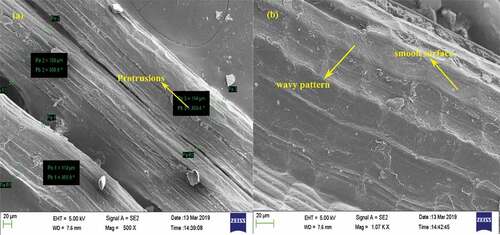
Due to the 5% MgCO3 treatment, the CQSF has an irregular arrangement, uneven distribution, and rough surface, as shown in . It confirms the reduction of non-cellulosic contents and impurities present in the fiber. Due to the rough surface following chemical treatment, the interfibrillar space in the untreated CQSF increases which confirms the reduction of non-cellulosic components such as hemicellulose, lignin, pectin, and wax. Moreover, bifurcate fibrils are visible with an absence of impurities, and this also indicates the increase in the interfibrillar space of the fiber, as shown in . In the longitudinal direction, irregular surfaces are noted with grooves on the fiber which are believed to help capillary action, air permeability, and hygroscopicity. In general, the surface of the fiber is conducive to holding an advantageous effect on the interlocking of fiber and the resin which leads to the attainment of better mechanical properties of polymer composites. It helps to interchange the tangential stress distribution between the resin and fiber.
Conclusion
The Cissus quadrangularis fiber is extracted from the stem of the plant. It is subjected to microbiological degradation and then chemically treated with MgCO3, NaOH, Na2CO3, NaHCO3, and Ca(OH)2. The single-fiber tensile test of the untreated CQSF reveals that the critical fiber length is 40 mm with a tensile strength of 145.96 ± 29.16 MPa and there is an increase in the tensile strength of the chemically treated CQSF compared to the untreated CQSF. Among all the chemically treated and untreated CQSF samples, the 5% MgCO3-treated CQSF has a higher tensile strength of 185.57 ± 20.53 MPa. The density of the 5% MgCO3-treated CQSF is higher than that of the untreated CQSF due to the increase in the cellulose content. The chemical composition analysis reveals the higher cellulose content (65.48%) in the 5% MgCO3-treated CQSF. The TGA results reveal that there is an increase of 235°C in the thermal stability and 335°C in the degradation temperature for the 5% MgCO3-treated CQSF compared to the untreated CQSF. The FESEM morphological analysis shows that the chemical treatment with 5% MgCO3 increases the surface roughness of the fibers. All these results support that the MgCO3 chemical treatment on CQSF improves mechanical properties over untreated CQSF and the same could be considered for reinforcement material in a polymeric matrix.
Highlights
FESEM revealed presence of rough surface due to the removal of lignin in chemically treated fiber.
Chemical treatment on lignocellulosic Cissus quadrangularis fiber.
Single-fiber tensile test on untreated and chemically treated fiber was evaluated.
Thermal stability and thermal degradation temperature were examined for untreated and chemically treated fiber.
Disclosure statement
The authors declare that they have no known competing financial interests or personal relationships that could have appeared to influence the work reported in this paper.
Additional information
Funding
References
- Belaadi, A., S. Amroune, and M. Bourchak. 2020. Effect of eco-friendly chemical sodium bicarbonate treatment on the mechanical properties of flax fibres: Weibull statistics. International Journal of Advanced Manufacturing Technology 106 (5–6):1753–10. doi:10.1007/s00170-019-04628-8.
- Binoj, J. S., R. Edwin Raj, V. S. Sreenivasan, and G. Rexin Thusnavis. 2016. Morphological, physical, mechanical, chemical and thermal characterization of sustainable Indian areca fruit husk fibers (Areca catechu L.) as potential alternate for hazardous synthetic fibers. Journal of Bionic Engineering 13 (1):156–65. doi:10.1016/S1672-6529(14)60170-0.
- Hossain, S. I., M. Hasan, M. N. Hasan, and A. Hassan. 2013. Effect of chemical treatment on physical, mechanical and thermal properties of ladies finger natural fiber. Advances in Materials Science and Engineering 2013:1–6. doi:10.1155/2013/824274.
- Ibrahim, N. A., W. Md Zin Wan Yunus, M. Othman, and K. Abdan. 2011. Effect of chemical surface treatment on the mechanical properties of reinforced plasticized poly (lactic acid) biodegradable composites. Journal of Reinforced Plastics and Composites 30 (5):381–88. doi:10.1177/0731684410396595.
- Jagadeesh, P., V. Sagar Honnenahally Ningappa, M. Puttegowda, Y. Gowda Thyavihalli Girijappa, S. Mavinkere Rangappa, M. Rizwan Khan, I. Khan, and S. Siengchin. 2021. Pongamia pinnata shell powder filled Sisal/Kevlar Hybrid Composites: Physicomechanical and morphological characteristics. Polymer Composites 42 (9):4434–47. doi:10.1002/PC.26160.
- Kommula, V. P., K. Obi Reddy, M. Shukla, T. Marwala, and A. Varada Rajulu. 2013. Physico-chemical, tensile, and thermal characterization of Napier grass (Native African) fiber strands. International Journal of Polymer Analysis and Characterization 18 (4):303–14. doi:10.1080/1023666X.2013.784935.
- Kumaar, A. S., A. Senthilkumar, S. S. Saravanakumar, P. Senthamaraikannan, L. Loganathan, and B. Muthu Chozha Rajan. 2020. Mechanical properties of alkali-treated carica papaya fiber-reinforced epoxy composites. Journal of Natural Fibers 19:1–11. doi:10.1080/15440478.2020.1739590.
- Kumar, S., V. K. Patel, K. K. S. Mer, B. Gangil, T. Singh, and G. Fekete. 2021. Himalayan natural fiber-reinforced epoxy composites: Effect of Grewia optiva/Bauhinia vahlii fibers on physico-mechanical and dry sliding wear behavior. Journal of Natural Fibers 18 (2):192–202. doi:10.1080/15440478.2019.1612814.
- Madhu, P., M. R. Sanjay, A. Khan, A. A. Otaibi, A.A.Z. Salma, S. Pradeep, B. Yogesha, P. Boonyasopon, and S. Siengchin. 2022. Hybrid effect of PJFs/E-glass/carbon fabric reinforced hybrid epoxy composites for structural applications. Journal of Natural Fibers 19 (10):3742–52. doi:10.1080/15440478.2020.1848724.
- Madhu, P., M. R. Sanjay, P. Senthamaraikannan, S. Pradeep, S. Siengchin, M. Jawaid, and M. Kathiresan. 2020. Effect of various chemical treatments of Prosopis juliflora fibers as composite reinforcement: Physicochemical, thermal, mechanical, and morphological properties. Journal of Natural Fibers 17 (6):833–44. doi:10.1080/15440478.2018.1534191.
- Mayandi, K., N. Rajini, P. Pitchipoo, V. Arumugaprabu, P. K. Vishnudev, M. Vetrivel, and K. Vignesh. 2015. Effect of alkali treatment on tensile and physicochemical characterization of Cissus quadrangularis fiber. Applied Mechanics and Materials 813–814:172–78. doi:10.4028/scientific.net/AMM.813-814.172.
- Mayandi, K., N. Rajini, P. Pitchipoo, J. T. Winowlin Jappes, and A. Varada Rajulu. 2016. Extraction and characterization of new natural Lignocellulosic fiber Cyperus Pangorei. International Journal of Polymer Analysis and Characterization 21 (2):175–83. doi:10.1080/1023666X.2016.1132064.
- Puttegowda, M., S. Mavinkere Rangappa, A. Khan, S. Ahmed Al-Zahrani, A. Al Otaibi, P. Shivanna, Y. Liu, and S. Siengchin. 2021. Effect of layering sequence on impact properties of alkali treated phoenix pusilla fibers-glass-carbon fabrics reinforced hybrid composite laminates. Journal of Natural Fibers 19 (13):6878–88. doi:10.1080/15440478.2021.1932683.
- Puttegowda, M., S. M. Rangappa, A. Khan, S. Ahmed Al-Zahrani, A. Al Otaibi, P. Shivanna, M. M. Moure, and S. Siengchin. 2020. Preparation and characterization of new hybrid polymer composites from Phoenix pusilla fibers/E-glass/carbon fabrics on potential engineering applications: Effect of stacking sequence. Polymer Composites 41 (11):4572–82. doi:10.1002/PC.25734.
- Santos, J. C. D., L. Á. D. Oliveira, L. M. Gomes Vieira, V. Mano, R. T. S. Freire, and T. H. Panzera. 2019. Eco-friendly sodium bicarbonate treatment and its effect on epoxy and polyester coir fibre composites. Construction and Building Materials 211:427–36. doi:10.1016/J.CONBUILDMAT.2019.03.284.
- Siva, R., K. Nikhil Kumar, and S. Mupparaju. 2021a. Study on physicochemical properties and morphology of surface-modified and raw Coccinia grandis natural fiber. Materials Today: Proceedings 47:4454–58. doi:10.1016/J.MATPR.2021.05.312.
- Siva, R., T. N. Valarmathi, K. Palanikumar, and V. S. Antony. 2020. Study on a novel natural cellulose fiber from Kigelia africana fruit: Characterization and analysis. Carbohydrate Polymers 244 (September):116494. doi:10.1016/j.carbpol.2020.116494.
- Siva, R., T. N. Valarmathi, A. V. Samrot, and J. Jeya Jeevahan. 2021b. Surface-modified and untreated Cissus quadrangularis reinforced polylactic composite. Current Research in Green and Sustainable Chemistry 4 (January):100121. doi:10.1016/j.crgsc.2021.100121.
- Sood, M., and G. Dwivedi. 2018. Effect of fiber treatment on flexural properties of natural fiber reinforced composites: A review. Egyptian Journal of Petroleum Egyptian Petroleum Research Institute 27 (4):775–83. doi:https://doi.org/10.1016/j.ejpe.2017.11.005.
- Vinod, A., R. Vijay, D. Lenin Singaravelu, M. Anish Khan, R. Sanjay, S. Siengchin, F. Verpoort, A. A. Khalid, and M. A. Abdullah. 2020. Effect of alkali treatment on performance characterization of Ziziphus mauritiana fiber and its epoxy composites. Journal of Industrial Textiles 51 (2_suppl):2444S–66S. doi:10.1177/1528083720942614.
- Yashas Gowda, T. G., A. Vinod, P. Madhu, M. R. Sanjay, S. Siengchin, and M. Jawaid. 2022. Areca/synthetic fibers reinforced based epoxy hybrid composites for semi-structural applications. Polymer Composites 43 (8):5222–34. doi:10.1002/PC.26814.

